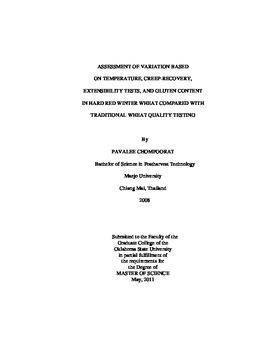| dc.contributor.advisor | Rayas-Duarte, Patricia | |
| dc.contributor.author | Chompoorat, Pavalee | |
| dc.date.accessioned | 2014-04-15T20:12:41Z | |
| dc.date.available | 2014-04-15T20:12:41Z | |
| dc.date.issued | 2011-05-01 | |
| dc.identifier.uri | https://hdl.handle.net/11244/8802 | |
| dc.description.abstract | The overall purpose of this study was to explore the potential improvement of differentiation of the properties of wheat samples by the use of methodology not used at the present time in breeding programs and in quality control protocols in the milling and baking industry. Gluten analyzed by a creep-recovery method at 25, 35, 45 and 55C was used in six hard red wheat and one soft red winter wheat samples. Creep-recovery plus extensibility of gluten and gluten content were compared with mixing, baking and protein sedimentation parameters to assess the improvement in explained variance using Principal Component Analysis (PCA). Two stresses (40 and 100 Pa) were used to determine potential improvement in the ability to separate gluten properties. Commercial (6) and breeder hard red winter flour samples (102) were analyzed with creep recovery at 100 Pa (25C) along with the extensibility, gluten content and traditional wheat breeder quality tests. PCA demonstrated that the viscoelastic properties of hard and soft red winter wheat flours are separated into two distinct groups with gluten analyzed 45 and 55C associated with separation time (SeP) suggesting the presence of more entanglements compared to those at 25 and 35C. At 25 and 35C, the gluten samples were associated with %Recoverability (RCY) suggesting more elastic behavior (stiffer glutens) compared to glutens at 45 and 55C. Creep-recovery tests at 100 Pa were able to separate better the viscoelastic behavior of gluten compared to 40 Pa. The main contributors to the highest percent of explained variance (83.8%) were creep recovery parameters obtained at 100 Pa (first principal component), loaf volume (LV) and flour protein (FP) (associated with the second principal component). When the traditional methods and the three suggested methods (creep-recovery, extensibility test, and gluten content) were analyzed together, the PCA for the breeder samples sets for 2008 and 2009 had similar total explained variance. The parameters with the highest contribution to the variance were selected for a new PCA and an improvement of the total explained variance was demonstrated (77.0% for 2008 and 51.3% for 2009). In summary, creep-recovery and tensile test parameters improved the discrimination of wheat samples and they were independent of baking properties. | |
| dc.format | application/pdf | |
| dc.language | en_US | |
| dc.publisher | Oklahoma State University | |
| dc.rights | Copyright is held by the author who has granted the Oklahoma State University Library the non-exclusive right to share this material in its institutional repository. Contact Digital Library Services at lib-dls@okstate.edu or 405-744-9161 for the permission policy on the use, reproduction or distribution of this material. | |
| dc.title | Assessment of Variation Based on Temperature, Creep-recovery, Extensibility Tests, and Gluten Content in Hard Red Winter Wheat Compared with Traditional Wheat Quality Testing | |
| dc.type | text | |
| dc.contributor.committeeMember | McGlynn, William | |
| dc.contributor.committeeMember | Bowser, Tim | |
| osu.filename | Chompoorat_okstate_0664M_11285.pdf | |
| osu.college | Agricultural Sciences and Natural Resources | |
| osu.accesstype | Open Access | |
| dc.description.department | Department of Animal Science | |
| dc.type.genre | Thesis | |
